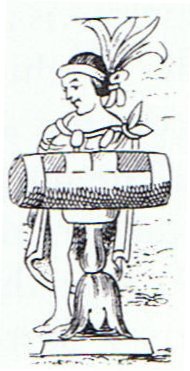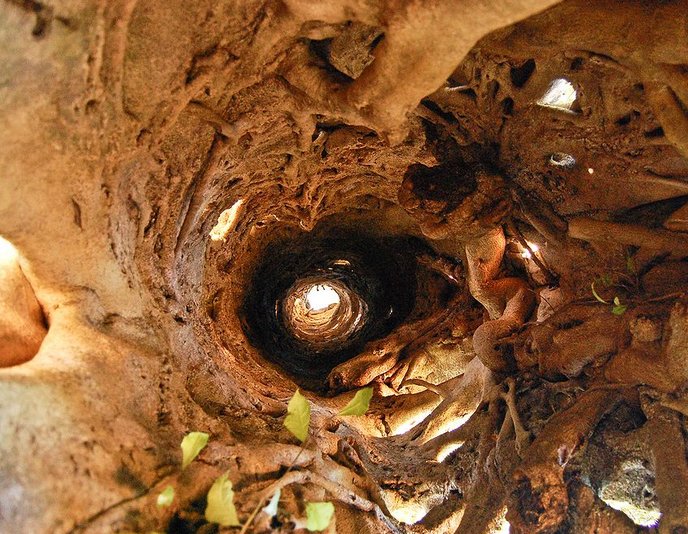The Mayas had a hollow log drum where (according to my reconstruction) 3 * 20 + 5 = 65 days remained of the year:
... The tun glyph was identified as a wooden drum by Brinton (1895, p. 92), and Marshal H. Saville immediately accepted it. Figure 49 [excerpt above] shows the Aztec drum representation relied on by Brinton to demonstrate his point. It was not then known that an ancestral Mayan word for drum was *tun: Yucatec tunkul 'divine drum' (?); Quiche tun 'hollow log drum'; Chorti tun 'hollow log drum' ... This hollow tree drum represents, I suggest, the body of the once flowering Tree at midsummer ('noon'). ... What I saw stunned me, for in her hand lay a perfect replica of the earflares worn by the Classic Maya kings. Suddenly I understood the full symbolism of so many of the things I had been studying for years. The kings dressed themselves as the Wakah-Chan tree, although at the time I didn't know it was also the Milky Way. The tzuk [partition] head on the trunk of the tree covered their loins. The branches with their white flowers bent down along their thighs, the double-headed ecliptic snake rested in their arms, and the great bird Itzam-Yeh stood on their head. I already knew as I stood under the young tree in Tikal that the kings were the human embodiment of the ceiba as the central axis of the world. As I stood there gazing at the flowers in Joyce's hand, I also learned that the kings embodied the ceiba at the moment it flowers to yield the sak-nik-nal, the 'white flowers', that are the souls of human beings. As the trees flowers to reproduce itself, so the kings flowered to reproduce the world ... The quadrant from midsummer to autumn equinox could have corresponded to the result of sexual intercourse (mixing the male and female genes) - viz. the flowering season of Virgo with Mercury. A month (20 = 192 - 172 days) beyond midsummer (8 Mol) raindrop tears like grapes were hanging down from above
20 * 4 = 80 and 192 + 80 = 272 (= 2 * 136 = 4 * 68). Then the male had finished his destination and like an old dry tree should be felled. Afterwards his corpse could be made into a drum (or a coffin, or a ship, etc). ... But Osiris's evil brother, Set, whose sister-wife was the goddess Nephtys, was mortally jealous both of his virtue and of his fame, and so, stealthily taking the measure of his good brother's body, he caused a beautifully decorated sarcophagus to be fashioned and on a certain occasion in the palace, when all were drinking and making merry, had it brought into the room and jestingly promised to give it to the one whom it should fit exactly. All tried, but, like the glass slipper of Cinderella, it fitted but one; and when Osiris, the last, laid himself within it, immediately a company of seventy-two conspirators with whom Set had contrived his plot dashed forward, nailed the lid upon the sarcophagus, soldered it with molten lead, and flung it into the Nile, down which it floated to the sea. Isis, overwhelmed with grief, sheared off her locks, donned mourning, and searched in vain, up and down the Nile; but the coffin had been carried by the tide to the coast of Phoenicia, where, at Byblos, it was cast ashore. A tamarisk immediately grew up around it, enclosing the precious object in its trunk, and the aroma of this tree then was so glorious that the local king, and queen, Melqart and Astarte - who were, of course, a divine king and queen themselves, the local representatives, in fact, of the common mythology of Damuzi and Inanna, Tammuz and Ishtar, Adonis and Aphrodite, Osiris and Isis - discovering and admiring its beauty, had the tree felled and fashioned into a pillar of their palace ... In India the banyan would have been suitable as a World Tree:
And on Easter Island it surely must have been the makoi tree, because the name of the explorer who should remain on the island was Makoi.
|



















